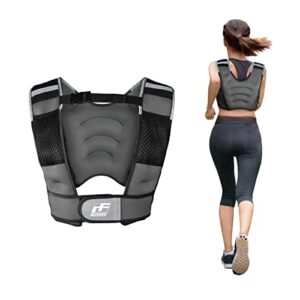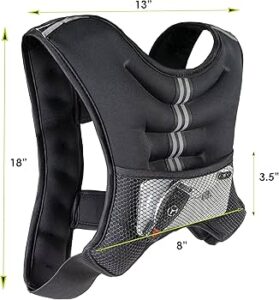

Wearing a weight vest might seem like a simple way to level up your workouts—but have you ever stopped to consider what that extra load is doing to your neck?
As fitness routines get more intense and gear like weighted vests becomes more mainstream, many people overlook one crucial area: the cervical spine.
This delicate segment of your spine, located in the neck, carries the weight of your head every single day—and adding external weight can change everything.
From spinal alignment shifts to muscle strain and disc pressure, the effects on your neck can be both subtle and serious.
Whether you are using a weight vest for strength training, endurance runs, or bodyweight exercises, it is time to ask the tough question: how safe is it for your cervical spine?
This article by BestForwardHeadPostureFix research team breaks down the science behind the impact of weight vests on your neck—not just what happens, but why it happens.
With spinal health on the line, understanding the biomechanics involved isn’t optional—it’s essential.
If you’re committed to training smarter and protecting your body long-term, you need to know exactly how this popular tool could be silently reshaping your spine.
Let’s dive deep into the real cost of strapping on that extra weight.
Index:
- Understanding the Cervical Spine
- How Weight Vests Influence Spinal Alignment
- Increased Load and Cervical Muscle Strain
- Effects on Intervertebral Discs
- Postural Adjustments and Their Consequences
- Potential for Neck Pain and Injury
- Guidelines for Safe Use of Weight Vests
- Conclusion
Understanding the Cervical Spine
The cervical spine, comprising the first seven vertebrae (C1-C7) in the neck region, serves as a pivotal structure supporting the head’s weight and facilitating a wide range of movements, including rotation, flexion, and extension.
This segment of the spine is uniquely structured to balance flexibility and strength, allowing for the intricate motions required in daily activities.
Encased within this region are critical components such as the spinal cord, nerve roots, and blood vessels, all protected by the vertebrae and intervertebral discs.
Given its anatomical complexity and the constant load it bears, the cervical spine is particularly susceptible to strain and injury when subjected to additional stressors, such as the added weight from a vest.
Understanding the biomechanics and vulnerabilities of the cervical spine is essential for recognizing how external loads can impact its function and integrity.
How Weight Vests Influence Spinal Alignment?
Introducing a weight vest alters the body’s center of gravity by adding external load to the torso.
This additional weight necessitates compensatory adjustments in posture to maintain balance and stability during movement.
Specifically, individuals may experience a forward shift in the upper body, leading to an increased curvature in the cervical and thoracic regions.
Such changes can disrupt the natural alignment of the spine, placing undue stress on the cervical vertebrae and associated musculature.
Over time, these alterations may contribute to postural imbalances, muscle fatigue, and discomfort in the neck area.
It is crucial to be aware of these potential shifts and consciously engage in maintaining proper posture when using weight vests to mitigate adverse effects on spinal alignment.
Increased Load and Cervical Muscle Strain
The additional weight from a vest imposes greater demands on the cervical muscles, which are responsible for supporting the head and facilitating neck movements.
This increased load requires these muscles to exert more effort to stabilize the head and maintain proper posture, especially during dynamic activities.
As a result, individuals may experience muscle fatigue, tightness, and strain in the neck region.
Prolonged exposure to such strain without adequate rest and recovery can lead to discomfort and may increase the risk of musculoskeletal issues.
Therefore, it’s essential to monitor the body’s response to the added weight and ensure that the cervical muscles are not overburdened, incorporating rest periods and stretching exercises (such as neck stretches) as needed to alleviate muscle tension.
Effects on Intervertebral Discs
Intervertebral discs act as cushions between the vertebrae, absorbing shocks and facilitating smooth movements of the spine.
When additional weight is introduced through a vest, the compressive forces on these discs increase, particularly in the cervical region.
This heightened pressure can accelerate disc wear and tear, potentially leading to conditions such as disc degeneration or herniation over time.
Individuals with pre-existing spinal conditions should exercise caution, as the added load may exacerbate these issues.
It is advisable to consult with a healthcare professional before incorporating weight vests into exercise routines to assess the potential impact on spinal health and ensure that the intervertebral discs are not subjected to excessive stress.
Postural Adjustments and Their Consequences
To accommodate the extra load from a weight vest, individuals often make unconscious postural adjustments, such as tilting the head forward, rounding the shoulders, or arching the back.
These compensatory movements can disrupt the spine’s natural curvature, leading to muscle imbalances and increased strain on the cervical region.
Over time, such misalignments can contribute to discomfort and heighten the risk of developing chronic neck pain or other musculoskeletal issues.
Awareness of these tendencies is crucial, and individuals should focus on maintaining proper posture, engaging core muscles, and ensuring that the weight is evenly distributed to mitigate these adverse effects.
Regularly practicing posture-correcting exercises can also help in counteracting the negative consequences of these adjustments.
Potential for Neck Pain and Injury
Consistent use of weight vests without proper attention to form and posture can increase the risk of developing neck pain or sustaining injuries.
The cumulative effect of increased muscle strain, altered spinal alignment, and heightened disc compression underscores the importance of mindful usage.
Individuals may experience symptoms ranging from mild discomfort to severe pain, potentially leading to conditions such as cervical spondylosis or nerve impingement.
To minimize these risks, it is essential to listen to the body’s signals, avoid overloading, and prioritize proper technique during exercises involving weight vests.
Seeking guidance from fitness professionals can also aid in developing a safe and effective training regimen that accounts for individual capabilities and limitations.
Guidelines for Safe Use of Weight Vests
To mitigate adverse effects on the cervical spine when using weight vests, it is crucial to implement safe and progressive practices:
- Start with Light Weights: Begin with a vest that is no more than 5–10% of your body weight. This allows your musculoskeletal system, particularly the cervical spine, to adapt gradually to the added load without undue stress. Overloading too quickly can lead to neck strain, disc compression, or nerve impingement.
- Monitor Posture: Always maintain an upright posture during activities, keeping your shoulders back and your head aligned directly over the spine. Poor posture, especially forward head position, increases pressure on the cervical vertebrae and may lead to muscle fatigue or injury.
- Strengthen Supporting Muscles: Incorporate strength training exercises targeting the neck, shoulders, upper back, and core. A strong support system helps stabilize the spine and evenly distribute weight, reducing the risk of strain on the cervical region.
- Limit Duration: Initially, limit the amount of time you wear the vest, especially during high-impact or long-duration activities. Gradually increase duration as your body adapts to prevent overuse injuries.
- Choose Ergonomic Vests: Select weight vests that distribute weight evenly across the torso. Uneven or poorly-fitted vests can shift the center of gravity and place uneven pressure on the spine.
- Consult a Professional: Before starting, consult with a certified fitness trainer or healthcare professional, especially if you have a history of neck or spinal issues. They can provide personalized recommendations and ensure proper form and usage.
Conclusion
While weight vests can be valuable tools for enhancing physical fitness, it’s imperative to recognize and address their impact on the cervical spine.
The neck is a highly sensitive area, responsible for supporting the head and facilitating complex movements—any disruption to its function can lead to lasting discomfort or injury.
Understanding the biomechanical changes that occur when wearing a weight vest, including altered alignment, increased muscular strain, and added disc pressure, is essential for preventing long-term complications.
Many people incorporate weight vests without realizing how small postural deviations can gradually translate into chronic neck pain or structural damage.
However, with a proactive approach that includes starting with lighter loads, maintaining proper form, strengthening supporting muscles, and limiting wear time, these risks can be significantly reduced.
By following expert-recommended practices and staying mindful of the body’s warning signs, fitness enthusiasts can enjoy the strength-building advantages of weight vests while protecting one of the most vulnerable parts of their spine—the cervical region.
References:

